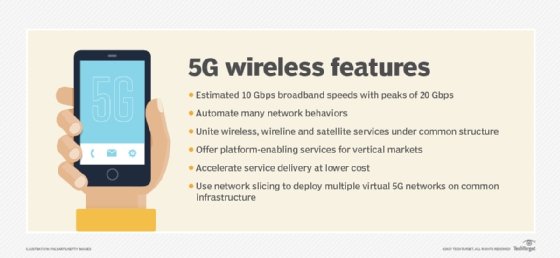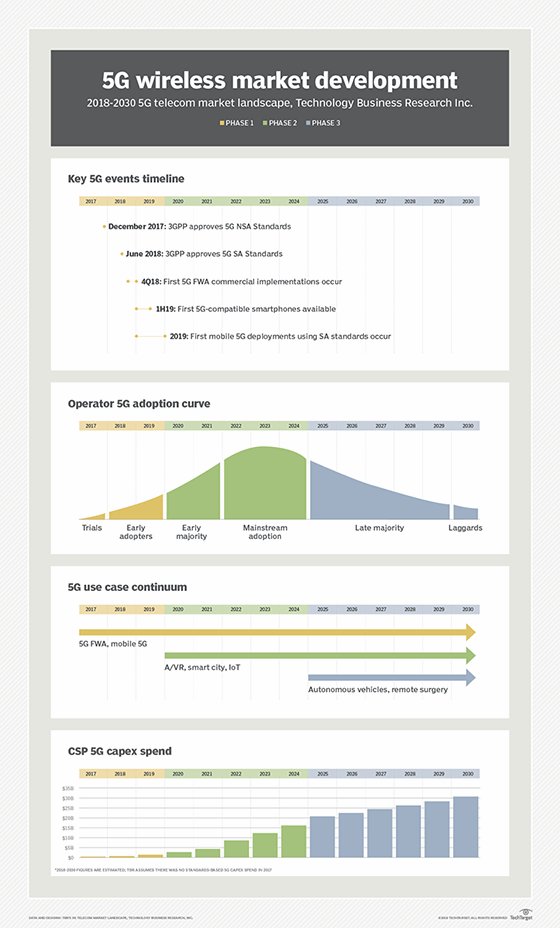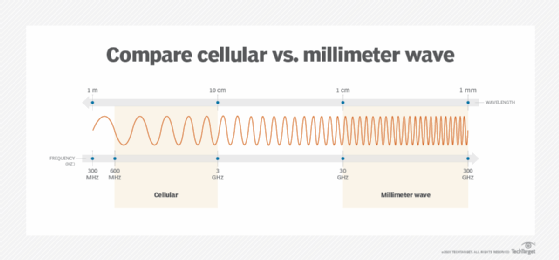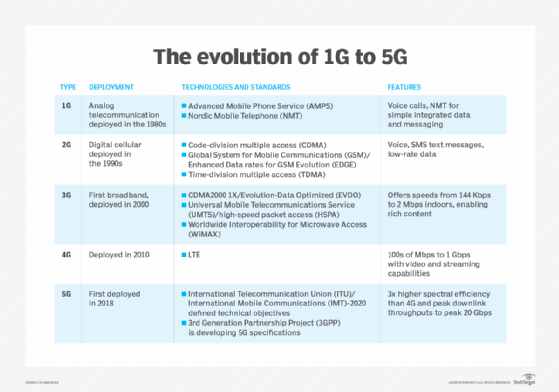5G
What is 5G?
Fifth-generation wireless (5G) is the latest iteration of cellular technology. 5G was engineered to greatly increase the speed and bandwidth of wireless networks while also reducing latency when compared to previous wireless standards.
5G is ideal for telecommunications, internet of things (IoT) and for private networks using private 5G. Cellular companies began deploying 5G networks in 2019 as the successor to fourth-generation wireless (4G).
With 5G, data transmitted over wireless broadband connections can travel at multigigabit speeds, with potential ideal peak download speeds as high as 20 gigabits per second (Gbps). These speeds exceed wireline network speeds and can offer latency of below 5 milliseconds (ms) or lower, which is useful for applications that require real-time feedback. 5G enables a sharp increase in the amount of data transmitted over wireless systems due to more available bandwidth and advanced antenna technology.
Overall, 5G is expected to generate a variety of new applications, uses and business cases as the technology is rolled out.
How does 5G work?
5G is enabled by a 5G New Radio (5G NR) air interface design, which acts as a specification for 5G networks -- describing how 5G products transmit data with 5G NR network infrastructure. 5G uses orthogonal frequency-division multiple access, the same radio access technology as 4G LTE networks use. In this way, 4G LTE wireless technology provides the foundation for 5G. Moreover, 5G also uses newer techniques such as quadrature amplitude modulation or QAM, beamforming, and other new features that increase the efficiency of a network and lower latency.
5G wireless networks are composed of cell sites divided into sectors that send data through radio waves. Unlike 4G, which requires large, high-power cell towers to radiate signals over longer distances, 5G wireless signals are transmitted through large numbers of small cell stations located in places like light poles or building roofs. The use of multiple small cells is necessary, as the millimeter wave (mmWave) spectrum -- the band of that 5G relies on to generate high speeds -- can only travel over short distances and is subject to interference from weather and physical obstacles.
MmWave frequencies can be easily blocked by objects such as trees, walls and buildings -- meaning that, much of the time, mmWave can only cover about a city block within direct line of sight of a cell site or node. Different approaches have been worked on to get around this issue. A brute-force approach involves using multiple nodes around each block of a populated area so that a 5G-enabled device can use an air interface -- switching from node to node while maintaining MM wave speeds.

Another, more feasible, way of offsetting the challenges relating to distance and interference with mmWave is using it in conjunction with a lower frequency wireless spectrum -- called Sub-6 5G.
The 5G spectrum is divided into mmWaves (high-band) and Sub-6 5G (low- and mid-bands). Although not as fast as mmWaves, Sub-6 5G is still typically faster than average 4G LTE speeds. Low-band frequencies are the slowest of 5G speeds, but are still faster than some 4G LTE speeds. Mid-band, by comparison, is faster than low-band, but is still eclipsed by mmWave.
Sub-6 5G reaches greater distances than mmWaves, but has lower speed and capacity compared to mmWave.
MmWave is still used in densely populated areas, while Sub-6 frequencies can be used in less dense areas. The lower-end frequencies can travel up to hundreds of square miles. This means that an implementation of all 5G frequency bands provides blanketed coverage while providing the fastest speeds in the most highly trafficked areas.

How fast is 5G?
Each band in the 5G spectrum operates at different speeds:
- Low bands provide speeds under 1 gigahertz (GHz), but can still provide speeds faster than some 4G LTE speeds.
- Mid-band provides speeds that range from 3.4GHz to 6GHz.
- The mmWave band, by comparison, is 30 GHz to 300 GHz.
Each band's speed varies depending on factors such as the carrier, distance, amount of traffic on the network, or obstacles (in the case of mmWaves).

Although 5G service is now widely available, it's not the initial replacement to 4G many thought it would be. While there are areas today with fast multi-gigabit download speeds, it's much more likely that users will encounter mid- or low-band 5G speeds. Even in a city block that provides mmWave 5G, its speed will diminish if the signal has to travel through a wall. Because of this, many users might notice only a minor speed improvement compared to 4G.
5G speeds are still considered fast in most cases, making consumer uses such as wirelessly streaming videos in 4K resolutions much more viable.
What are the benefits of 5G?
Even though the downsides of 5G are clear when considering how easily mmWave can be blocked, 5G still has plenty of worthy benefits, including the following:
- Use of higher frequencies.
- High bandwidth.
- Enhanced mobile broadband.
- A lower latency of 5 ms.
- Higher data rates, which will enable new technology options over 5G networks, such as 4K streaming or near-real-time streaming of virtual reality.
- The flexibility in coverage, having a mobile network made up of low-band, mid-band and mmWave frequencies.
5Gs launch
Around the same time as the initial launch of 5G in 2019, the first 5G-compliant smartphones and associated devices started becoming commercially available.
At first, carrier 5G deployments were underwhelming, as some companies chose to build up their low-band infrastructure first. Although still 5G, it was not providing the blinding speed advertised by many carriers -- as that would come with mmWaves. Verizon was an early adopter of building their 5G mmWave architecture; however, this process is expensive and, at first, was only provided in a limited number of specific city areas.
Since 2019, many 5G carriers have had time to build up their 5G sub-6 and mmWave deployments. Many companies like Verizon or AT&T offer coverage maps on their websites, showing where they provide 5G mmWave, Sub-6 or 4G coverage. Each company has a different name for each band they offer, however. As an example, Verizon calls its 5G mmWave "5G Ultra Wideband," while AT&T calls its "5G+," and T-Mobile calls its "5G Ultra Capacity."
What types of 5G wireless services will be available?
Network operators are developing two types of 5G services:
- 5G cellular services provide user access to operators' 5G cellular networks. These services began to be rolled out in 2019 when the first 5G-enabled (or 5G-compliant) devices became commercially available. Cellular service delivery is also dependent upon the completion of mobile core standards by 3GPP.
- Private 5G delivers 5G cellular connectivity for private network use cases. An organization must own or rent 5G spectrum and infrastructure to enact a private 5G network. Private 5G works in the same way as a public 5G network, but the owners are able to provide restricted access to their network. Private 5G networks are deployable as either a service, wholly owned, hybrid or sliced private networks.
- 5G fixed wireless broadband services deliver internet access to homes and businesses without a wired connection to the premises. To do that, network operators deploy NRs in small cell sites near buildings to beam a signal to a receiver on a rooftop or a windowsill that is amplified within the premises. Fixed broadband services are expected to make it less expensive for operators to deliver broadband services to homes and businesses because this approach eliminates the need to roll out fiber optic lines to every residence. Instead, operators only need to install fiber optics to cell sites, and customers receive broadband services through wireless modems located in their residences or businesses.
5G vs. 4G: Key differences
Each generation of cellular technology differs in its data transmission speed and encoding methods, which require end users to upgrade their hardware. 4G can support up to 2 Gbps and is slowly continuing to improve in speed. 4G featured speeds up to 500 times faster than 3G. 5G can be up to 100 times faster than 4G.
One of the main differences between 4G and 5G is the level of latency, of which 5G has much less. 5G uses orthogonal frequency-division multiplexing (OFDM) encoding, similar to 4G LTE. 4G, however, uses 20 MHz channels bonded together at 160 MHz. 5G is up to between 100 and 800 MHz channels, which requires larger blocks of airwaves than 4G.
Samsung is currently researching 6G. Not too much is currently known about how fast 6G would be and how it would operate. However, 6G will probably operate in similar differences of magnitude as between 4G and 5G. Some think 6G might use mmWave on the radio spectrum and might be a decade away.
5G use cases
5G use cases can range from business and enterprise use to more casual consumer use. Some examples of how 5G can be used include the following:
- Streaming high-quality video.
- Communication among devices in an IoT environment.
- More accurate location tracking.
- Fixed wireless services.
- Low-latency communication.
- Better ability for real-time analytics.
In addition to improvements in speed, capacity and latency, 5G offers network management features -- among them network slicing, which enables mobile operators to create multiple virtual networks within a single physical 5G network. This capability will enable wireless network connections to support specific uses or business cases and could be sold on an as-a-service basis. A self-driving car, for example, could require a network slice that offers extremely fast, low-latency connections so a vehicle could navigate in real time. A home appliance, however, could be connected via a lower-power, slower connection because high performance is not crucial. IoT could use secure, data-only connections.
Business benefits of 5G
5G's impact on the economy
5G's value chain and its support of a broad range of industries have led to a notable impact on economies. A study from PwC predicted that, by 2030, the total impact on the US economy by 5G will be $1.3 trillion. And in 2019, the leading industries 5G has affected include healthcare at $530 billion, smart utilities at $330 billion, consumer and media applications at $254 billion, industrial manufacturing at $134 billion and financial-services applications at $85 billion.
In another report published by CTIA, in 2020, the wireless industry generated over $1.3 trillion and added almost 4.5 million jobs to the American economy.
Who is working on 5G?
Many of the big carriers are working on building up and expanding their 5G networks. This includes Verizon, AT&T and T-Mobile. Each carrier mentioned, for example, has embraced the idea of a multi-tier 5G strategy, which includes the use of low-band, mid-band and mmWave frequencies.
Likewise, 3GPP is working on more updates and improvements to their 5G specifications.
Why 5GE is not really 5G
Early on in its 5G development, AT&T released a 5GE network, where 4G LTE users received an update that "upgraded" them to 5GE. 5GE was just a rebranding of AT&T's Gb 4G LTE network, however.
AT&T argued that the offered speeds were close enough to 5G, but it still was not technically 5G. The G stands for generation, typically signaling a compatibility break with former hardware. Users wouldn't have been able to update their phones to support 5G; rather, they would have needed to get a new phone that supports 5G entirely. This was a marketing strategy that misled individuals who did not know the specifics behind the technology.
What 5G phones are available?
A phone or another piece of hardware can't just get a software update on a 4G phone to enable 5G. 5G requires specific hardware.
To be able to utilize 5G, a user must have a device that supports 5G, a carrier that supports 5G and be within an area that has a 5G node within range.
Most new phones released today are developed to support 5G. As an example, the iPhone 12 and up all support 5G, while the Google Pixel 5 and up support 5G.
History of cellular wireless technology
1G was launched by Nippon Telegraph and Telephone in 1979. By 1984, Japan became the first country to have the first generational network nationwide. Motorola introduced the first commercially available cellphone in 1983, called the DynaTAC.
The second generational network (2G) was released initially in Finland in 1991. 2G introduced significant improvements to mobile talk, such as improving sound quality, reducing static, and introducing encrypted calls. Another major addition to 2G was the ability to access media on cell phones by enabling the transfer of data bits.
The third-generation wireless (3G) was first introduced in 2001. 3G focused on standardizing network protocols from different vendors. The biggest improvement to 3G was its increased speed, which enabled users to browse the internet on their mobile devices. 3G had four times the data transferring capability. International roaming services were also introduced.
The fourth-generation wireless was introduced in 2009. 4G enabled users to stream high-quality video with faster mobile web access. In 2011, LTE networks began launching in Canada. 4G LTE can still commonly be found in areas where 5G isn't yet provided.
Work developing 5G began in 2015 by the 3GPP -- a collaborative group of telecommunications associations. 3GPP's initial goal was to develop globally applicable specifications for 3G mobile systems. The 3GPP meets four times a year to plan and develop new releases. Each release improves upon the last while providing new standardized functionalities.
In 2017, the fifth 5G and 5G NR specifications were released. One year later, in 2018, the 3GPP approved release 16, which included a few specifications, including network slicing.
5G saw its public release in 2019, with Verizon being among the first carriers to develop a 5G mobile network in both Chicago and Minneapolis. Other carriers like Sprint, AT&T and T-Mobile began launching their own 5G infrastructure and services around the same time. Some companies started focusing on higher-speed mmWave infrastructure, while others decided to invest in developing lower band frequencies first.
In 2020, 3GPP release 16 was published, which focused on applications of 5G, such as automotive and industrial IoT. Release 18 was launched in 2022 and covered system architecture and services, security, multimedia codecs, as well as management orchestration and charging features.

The history of wireless networks has seen numerous iterations, and as 5G continues to be adopted, we will continue to see new iterations, updates and improvements. Learn more about the 5G adoption and how different industries will benefit from it in this article.






